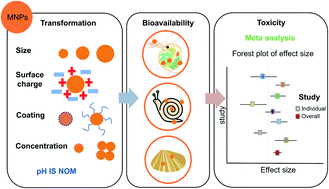Emerging investigator series: metal nanoparticles in freshwater: transformation, bioavailability and effects on invertebrates†
Abstract
The increasing use of metal oxide-based nanoparticles (MNPs) and their release into the environment cast concerns about their environmental impacts. Massive efforts have been focused on environmental behaviours and ecotoxicities to figure out the potential threats posed by MNPs. This review systematically summarises and re-analyses published data about the MNP interactions and transformation processes in freshwater and the toxicological effects of MNPs on invertebrates. A case study was conducted through meta-analysis to examine the impacts of silver nanoparticle exposure to freshwater invertebrates. The conclusions categorized the current understanding of the outcome and ecotoxicity of MNPs in freshwater. The adverse outcome pathway (AOP) is recommended for environmental risk assessment as it provides a rapid and accurate risk assessment of an increasing number of novel compounds consuming fewer resources and animal tests. Invertebrates contribute significantly towards developing robust AOPs thanks to a shorter life cycle, allowing chronic and complete life cycle toxicity tests.

- This article is part of the themed collections: Best Papers of 2022 from RSC’s Environmental Science journals, Best Papers 2022 – Environmental Science: Nano and Emerging Investigators Series


 Please wait while we load your content...
Please wait while we load your content...